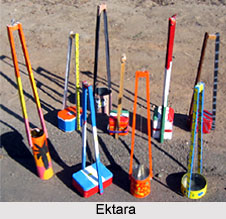 Music of the Bauls of Birbhum district is a reformed tune sung in folk style. This means that the nature of performance, rhythmic character and musical instrument accompanying songs establish the nature of total music on the ground of folk base. It is essentially a counterpart of the other type of Baul songs of the central area of Bengal, from where Baul has moved to all directions.
Music of the Bauls of Birbhum district is a reformed tune sung in folk style. This means that the nature of performance, rhythmic character and musical instrument accompanying songs establish the nature of total music on the ground of folk base. It is essentially a counterpart of the other type of Baul songs of the central area of Bengal, from where Baul has moved to all directions.
Popularity of Baul Music in Birbhum
The reasons for propagation is that though the theme is meditative, individualistic and symbolically expressed, yet the method of religious observance, as a purely sectarian thought, does not depend on any rite or ritual or stiff code, music being the only vehicle of expression. Music is accompanied by graceful movements of dance when Bauls stand in the close quarters of their own sectarian concert in rural areas only. Birbhum Bauls use some handy instruments like khamak, gopiyantra, ghungur, mandira, and bayan. These instruments are common in the central area, including the use of dotara which has been borrowed from the northern and eastern areas. In northern and eastern sectors the use of dotara is a common feature now. It should be mentioned that the instruments as used in the Radh area (khamak or gubguba, gopi yantra and fastened to leg or hand) are helpful to communicate ideas through dance rhythm, though Bauls do not cultivate full-fledged dance.
One can visualize a picture of a Birbhum Baul dancing thus; he stands slanted with a guarded fork-shaped instrument gopi yantra, on the one hand, and a bayan tied to the waist on the other side. While in dance, he combines his natural vocal music with a few movements depicting the climax of his inspiration. The fork-shaped gourded gopi yantra is often substituted by khamak. The form of tune of Bauls from Birbhum, as popular now, is a few phrases of Raga Bhairavi which do not generally occur in the folk-music of West Bengal. Bhairavi occurs in some folk-songs of Northern part of India, but that seems to be a rare feature.
Influence of Vaishnava in Bauls of Birbhum
 Vaishnava Bauls had close connection with the central area, perhaps with Kirtan, Shyamasangeet Kavi of eighteenth and nineteenth centuries. The tradition of music performance of the western sector (of Birbhum Bauls) is not that old, because these Bauls present a tune which became popular not before early nineteenth century, when Kaviwalas used to give recital in various forms of popular ragas.
Vaishnava Bauls had close connection with the central area, perhaps with Kirtan, Shyamasangeet Kavi of eighteenth and nineteenth centuries. The tradition of music performance of the western sector (of Birbhum Bauls) is not that old, because these Bauls present a tune which became popular not before early nineteenth century, when Kaviwalas used to give recital in various forms of popular ragas.
It is mentioned that Bauls have no religious codes for general observance of rites. Music and dance happen to be the primordial form of communication. Years of tradition have contributed to them the idea of annual congregation at places where they communicate their culture. Thus, they have had some particular localities where Baul fairs take place. For instance, Vaisnava Bauls, especially the Bauls of the Radh area, congregate each year at Kenduli (alternatively named as Jaydeva, because the spot is known as the birth place of Jaydeva) situated on the bank of the river Ajoy. Bauls arrive there on the pre-pous Sankranti day (last day of the month of Pous) coinciding with the late harvesting festival. It is difficult to say how they connect themselves with this special harvesting festival of Pous Sankranti, since the Bauls live outside the jurisdiction of any social observance. They perform non-stop music one after another under shades or in the open-air during the whole day or overnight for several days. The importance of this type of programme is emphasized by colourful dress - wearing coloured turban and gown of Sanyas, put on in an untidy manner, consciously though. The source of the use of this dress has been treated below. Bauls, influenced by Vaishnavism, are the representatives of this group cherishing Sahajiya cult. The details have been referred to again under Bauls of the central sector. The following is the Baul tune of Birbhum recorded outdoors




















